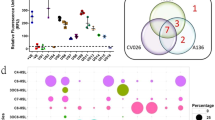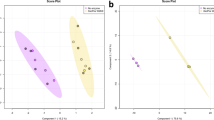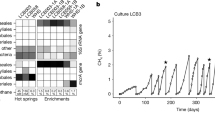Abstract
Acyl homoserine lactone (AHL)-based quorum sensing commonly refers to cell density-dependent regulatory mechanisms found in bacteria. However, beyond bacteria, this cell-to-cell communication mechanism is poorly understood. Here we show that a methanogenic archaeon, Methanosaeta harundinacea 6Ac, encodes an active quorum sensing system that is used to regulate cell assembly and carbon metabolic flux. The methanogen 6Ac showed a cell density-dependent physiology transition, which was related to the AHL present in the spent culture and the filI gene-encoded AHL synthase. Through extensive chemical analyses, a new class of carboxylated AHLs synthesized by FilI protein was identified. These carboxylated AHLs facilitated the transition from a short cell to filamentous growth, with an altered carbon metabolic flux that favoured the conversion of acetate to methane and a reduced yield in cellular biomass. The transcriptomes of the filaments and the short cell forms differed with gene expression profiles consistent with the physiology. In the filaments, genes encoding the initial enzymes in the methanogenesis pathway were upregulated, whereas those for cellular carbon assimilation were downregulated. A luxI–luxR ortholog filI–filR was present in the genome of strain 6Ac. The carboxylated AHLs were also detected in other methanogen cultures and putative filI orthologs were identified in other methanogenic genomes as well. This discovery of AHL-based quorum sensing systems in methanogenic archaea implies that quorum sensing mechanisms are universal among prokaryotes.
Similar content being viewed by others
Log in or create a free account to read this content
Gain free access to this article, as well as selected content from this journal and more on nature.com
or
Accession codes
References
Ahring BK, Alatriste-Mondragon F, Westermann P, Mah RA . (1991). Effects of cations on Methanosarcina thermophila TM-1 growing on moderate concentrations of acetate: production of single cells. Appl Microbiol Biotechnol 35: 686–689.
Cataldi TR, Bianco G, Abate S . (2008). Profiling of N-acyl-homoserine lactones by liquid chromatography coupled with electrospray ionization and a hybrid quadrupole linear ion-trap and Fourier-transform ion-cyclotron-resonance mass spectrometry (LC-ESI-LTQ-FTICR-MS). J Mass Spectrom 43: 82–96.
Cataldi TR, Bianco G, Abate S . (2009). Accurate mass analysis of N-acyl-homoserine-lactones and cognate lactone-opened compounds in bacterial isolates of Pseudomonas aeruginosa PAO1 by LC-ESI-LTQ-FTICR-MS. J Mass Spectrom 44: 182–192.
Cha C, Gao P, Chen YC, Shaw PD, Farrand SK . (1998). Production of acyl-homoserine lactone quorum-sensing signals by Gram-negative plant-associated bacteria. Mol Plant Microbe Interact 11: 1119–1129.
Doddema HJ, Vogels GD . (1978). Improved identification of methanogenic bacteria by fluorescence microscopy. Appl Environ Microbiol 36: 752–754.
Frommberger M, Hertkorn N, Englmann M, Jakoby S, Hartmann A, Kettrup A et al. (2005). Analysis of N-acyl homoserine lactones after alkaline hydrolysis and anion-exchange solid-phase extraction by capillary zone electrophoresis-mass spectrometry. Electrophoresis 26: 1523–1532.
Gobert GN, Moertel LP, Brindley J, McManus DP . (2009). Developmental gene expression profiles of the human pathogen Schistosoma japonicum. BMC Genomics 10: 128–146.
Hastings JW, Greenberg EP . (1999). Quorum sensing: the explanation of a curious phenomenon reveals a common characteristic of bacteria. J Bacteriol 181: 2667–2668.
Hwang I, Li PL, Zhang L, Piper KR, Cook DM, Tate ME et al. (1994). TraI, a LuxI homologue, is responsible for production of conjugation factor, the Ti plasmid N-acyl homoserine lactone autoinducer. Proc Natl Acad Sci USA 91: 4639–4643.
Jetten M, Stams A, Zehnder A . (1992). Methanogenesis from acetate: a comparison of the acetate metabolism in Methanothrix soehngenii and Methanosarcina spp. FEMS Microbiol Let 88: 181–197.
Li J, Hu B, Zheng P, Qaisar M, Mei L . (2008). Filamentous granular sludge bulking in a laboratory scale UASB reactor. Biores Technol 99: 3431–3438.
Ma K, Liu X, Dong X . (2006). Methanosaeta harundinacea, sp. nov., a novel acetate-scavenging methanogen isolated from a UASB reactor. Int J Sys Evol Microbiol 56: 127–131.
More MI, Finger D, Stryker JL, Fuqua C, Eberhard A, Winans SC . (1996). Enzymatic synthesis of a quorum-sensing autoinducer using defined substrates. Science 272: 1655–1658.
Ortori CA, Atkinson S, Chhabra SR, Cámara M, Williams P, Barrett DA . (2007). Comprehensive profiling of N-acylhomoserine lactones produced by Yersinia pseudotuberculosis using liquid chromatography coupled to hybrid quadrupole–linear ion trap mass spectrometry. Anal Bioanal Chem 387: 497–511.
Paggi RA, Martone CB, Fuqua C, De Castro RE . (2003). Detection of quorum sensing signals in the haloalkaliphilic archaeon Natronococcus occultus. FEMS Microbiol Let 221: 49–52.
Pearson JP, Passadori L, Iglewskit BH, Greenberg EP . (1995). A second N-acylhomoserine lactone signal produced by Pseudomonas aeruginosa. Proc Natl Acad Sci USA 92: 1490–1494.
Robinson RW . (1986). Life cycles in the methanogenic archaebacterium Methanosarcina mazei. Appl Environ Microbiol 52: 17–27.
Sharif DI, Gallon J, Smith CJ, Dudley E . (2008). Quorum sensing in Cyanobacteria: N-octanoyl-homoserine lactone release and response, by the epilithic colonial cyanobacterium Gloeothece PCC6909. ISME J 2: 1171–1182.
Steindler L, Venturi V . (2007). Detection of quorum-sensing N-acyl homoserine lactone signal molecules by bacterial biosensors. FEMS Microbiol Lett 266: 1–9.
Sun J, Daniel R, Wagner-Döbler I, Zeng AP . (2004). Is autoinducer-2 a universal signal for interspecies communication: a comparative genomic and phylogenetic analysis of the synthesis and signal transduction pathways. BMC Evol Biol 4: 36–46.
Valle A, Bailey MJ, Whiteley AS, Manefield M . (2004). N-acyl-L-homoserine lactones (AHLs) affect microbial community composition and function in activated sludge. Environ Microbiol 6: 424–433.
Val DL, Cronan Jr JE . (1998). In vivo evidence that S-adenosylmethionine and fatty acid synthesis intermediates are the substrates for the luxI family of autoinducer synthases. J Bacteriol 180: 2644–2651.
Waters CM, Bassler BL . (2005). Quorum sensing: cell-to-cell communication in bacteria. Annu Rev Dev Biol 21: 319–346.
Xun LY, Boone DR, Mah RA . (1988). Control of the life cycle of Methanosarcina mazei S-6 by manipulation of growth conditions. Appl Environ Microbiol 54: 2064–2068.
Yu Y, Lee C, Kim J, Hwang S . (2005). Group-specific primer and probe sets to detect methanogenic communities using quantitative real-time polymerase chain reaction. Biotechnol Bioeng 89: 670–679.
Zhou J, Bruns MA, Tiedje JM . (1996). DNA recovery from soils of diverse composition. Appl Environ Microbiol 62: 316–322.
Acknowledgements
We thank R Thauer for valuable discussions on the science impact of the study; Y Che for suggestion on chemical structure determination; and J Merritt for thoroughly editing the manuscript and G Xia for assistance with fluorescence imaging. This work was supported by National Natural Science Foundation of China under numbers 30621005, 30830007 and 31000011, and the Innovation Project of the PUMC Youth Foundation.
Author information
Authors and Affiliations
Corresponding author
Additional information
Supplementary Information accompanies the paper on The ISME Journal website
Supplementary information
Rights and permissions
About this article
Cite this article
Zhang, G., Zhang, F., Ding, G. et al. Acyl homoserine lactone-based quorum sensing in a methanogenic archaeon. ISME J 6, 1336–1344 (2012). https://doi.org/10.1038/ismej.2011.203
Received:
Revised:
Accepted:
Published:
Issue date:
DOI: https://doi.org/10.1038/ismej.2011.203
Keywords
This article is cited by
-
Methanogenic partner influences cell aggregation and signalling of Syntrophobacterium fumaroxidans
Applied Microbiology and Biotechnology (2024)
-
Potential roles of acyl homoserine lactones (AHLs) in nitrifying bacteria survival under certain adverse circumstances
Scientific Reports (2023)
-
Symbiotic Interactions of Archaea in Animal and Human Microbiomes
Current Clinical Microbiology Reports (2023)
-
Engineering anaerobic digestion via optimizing microbial community: effects of bactericidal agents, quorum sensing inhibitors, and inorganic materials
Applied Microbiology and Biotechnology (2021)
-
Oxygen availability affects the synthesis of quorum sensing signal in the facultative anaerobe Novosphingobium pentaromativorans US6-1
Applied Microbiology and Biotechnology (2021)



